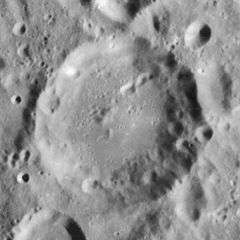Peirescius (crater)
Peirescius is a lunar impact crater that is located in the southeastern part of the Moon. It is close enough to the limb that it appears significantly foreshortened when viewed from the Earth, even though it is nearly circular in shape. To the west-northwest of Peirescius is the crater Vega, and less than one crater diameter to the south is Brisbane. Farther to the east is the Mare Australe.
 Lunar Orbiter 4 image | |
| Coordinates | 46.5°S 67.6°E |
|---|---|
| Diameter | 62 km |
| Depth | Unknown |
| Colongitude | 293° at sunrise |
| Eponym | Nicolas-Claude Fabri de Peiresc |
The outer parts of this crater has become eroded by smaller impacts, and several small craterlets lie along the rim or the inner wall. These have taken their toll upon the original crater shape, although it is nowhere near as badly eroded as the nearby Vega. The interior floor is a relatively featureless expanse, with only a low rise in the center and a small craterlet toward the northern rim.
The crater was named in 1935 after Nicolas-Claude Fabri de Peiresc (1580–1637), the French astronomer, antiquary and savant.
Satellite craters
By convention these features are identified on lunar maps by placing the letter on the side of the crater midpoint that is closest to Peirescius.
| Peirescius | Latitude | Longitude | Diameter |
|---|---|---|---|
| A | 45.2° S | 71.3° E | 15 km |
| B | 45.6° S | 70.5° E | 18 km |
| C | 46.2° S | 71.5° E | 41 km |
| D | 48.1° S | 71.9° E | 43 km |
| G | 48.1° S | 67.7° E | 25 km |
| H | 45.3° S | 73.1° E | 8 km |
| J | 45.1° S | 66.8° E | 15 km |
References
- Andersson, L. E.; Whitaker, E. A. (1982). NASA Catalogue of Lunar Nomenclature. NASA RP-1097.CS1 maint: ref=harv (link)
- Blue, Jennifer (July 25, 2007). "Gazetteer of Planetary Nomenclature". USGS. Retrieved 2007-08-05.CS1 maint: ref=harv (link)
- Bussey, B.; Spudis, P. (2004). The Clementine Atlas of the Moon. New York: Cambridge University Press. ISBN 978-0-521-81528-4.CS1 maint: ref=harv (link)
- Cocks, Elijah E.; Cocks, Josiah C. (1995). Who's Who on the Moon: A Biographical Dictionary of Lunar Nomenclature. Tudor Publishers. ISBN 978-0-936389-27-1.CS1 maint: ref=harv (link)
- McDowell, Jonathan (July 15, 2007). "Lunar Nomenclature". Jonathan's Space Report. Retrieved 2007-10-24.CS1 maint: ref=harv (link)
- Menzel, D. H.; Minnaert, M.; Levin, B.; Dollfus, A.; Bell, B. (1971). "Report on Lunar Nomenclature by the Working Group of Commission 17 of the IAU". Space Science Reviews. 12 (2): 136–186. Bibcode:1971SSRv...12..136M. doi:10.1007/BF00171763.CS1 maint: ref=harv (link)
- Moore, Patrick (2001). On the Moon. Sterling Publishing Co. ISBN 978-0-304-35469-6.CS1 maint: ref=harv (link)
- Price, Fred W. (1988). The Moon Observer's Handbook. Cambridge University Press. ISBN 978-0-521-33500-3.CS1 maint: ref=harv (link)
- Rükl, Antonín (1990). Atlas of the Moon. Kalmbach Books. ISBN 978-0-913135-17-4.CS1 maint: ref=harv (link)
- Webb, Rev. T. W. (1962). Celestial Objects for Common Telescopes (6th revised ed.). Dover. ISBN 978-0-486-20917-3.CS1 maint: ref=harv (link)
- Whitaker, Ewen A. (1999). Mapping and Naming the Moon. Cambridge University Press. ISBN 978-0-521-62248-6.CS1 maint: ref=harv (link)
- Wlasuk, Peter T. (2000). Observing the Moon. Springer. ISBN 978-1-85233-193-1.CS1 maint: ref=harv (link)